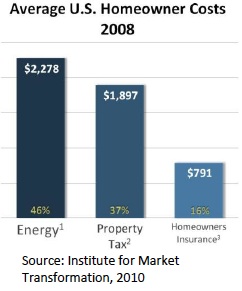Michael Chasnow is a Finance Analyst with the Environmental Finance Center.
At the EFC, we do a lot of work on energy efficiency and renewable energy (EERE) lending programs — from designing community energy finance programs to market assessments for EERE retrofit financing programs. Sometimes, it’s easy to to overlook why we try to scale energy efficiency retrofits. Why does energy efficiency matter, and why should individuals care?
There are several important reasons why energy efficiency matters, including:
- Dollar savings to individuals and organizations
- Energy savings that also reduce CO2 emissions
- Local jobs created
Dollar savings at the household level
Lets take each of these benefits individually. According to a McKinsey study there is an overall potential for $1.2 trillion in dollar savings in the U.S. by 2020, with an upfront investment of $520 billion in energy efficiency retrofit measures. That’s a whole lot of savings, but how does this $1.2 trillion affect individual households?
According to a 2010 Institute for Market Transformation study, the typical U.S. household spends about $2,300 annually on energy – more than the average cost of property taxes or homeowners insurance (see above visual). By incorporating relatively inexpensive improvements (i.e., insulation, sealing air ducts, weatherstripping and caulking) and undertaking more capital-intensive improvements (i.e., a new heat pump or HVAC system) when appropriate, 20% energy efficiency improvements would be quite attainable. This translates into an additional $470 per year of savings for the average U.S. family.
Substantial energy savings and greenhouse reductions
The McKinsey study Unlocking energy efficiency in the US Market explains it best. According to their calculations, the large-scale, upfront investment noted earlier could potentially reduce end-use energy consumption in 2020 by 9.1 quadrillion British Thermal Units (BTUs) – about 23% of US demand – and eliminate up to 1.1 gigatons of greenhouse gases annually.
Jobs created cost-effectively
Energy efficiency retrofits at scale create jobs in the struggling construction and home improvement industries. According to this Center for American Progress study, if 40% of the residential and commercial building stock in the U.S. was retrofitted across the next decade, 625,000 full-time sustained jobs would be created. In part through the 2009 American Recovery and Reinvestment Act (ARRA) and the Obama administration’s Better Buildings initiative, thousands of full-time jobs have already been created across the United States. Through ARRA, the Weatherization Assistance Program, and the Energy Efficiency Block Grant Programs, 530,000 buildings have undergone energy efficiency retrofits and almost 25,000 Americans have been employed to implement these retrofits through June 2011.
The same Center for American Progress study A Star Turn for Energy Efficiency Jobs, notes these jobs are also very cost-effective, with every $1 million invested in energy efficiency retrofits creating 17.36 jobs. When compared to the 6.86 or 5.18 jobs created by investment in the coal or oil & gas industries respectively for every $1 million invested, energy efficiency retrofits impact job creation by a factor of three. Moreover, 91% of the firms involved in retrofits are small businesses, according to research conducted by the Energy Future Coalition. For example, insulation is installed by more than 22,000 firms across the U.S., 85% of which employ fewer than 20 people.
Conclusion:
Energy efficiency = Dollar savings + energy savings + job creation. There are also positive health externalities from improved indoor air quality. In short, scaling energy efficiency retrofits is important!






Leave a Reply